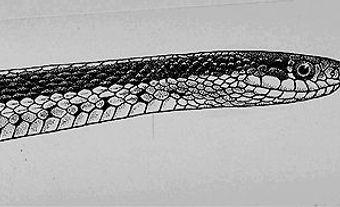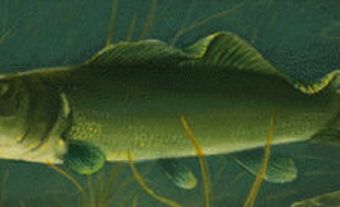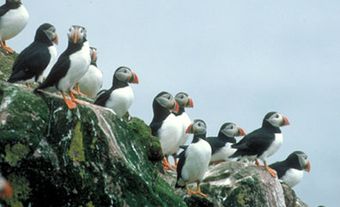Migration is defined restrictively as a regular movement between alternate sites, one of which is usually a breeding location. More broadly, it can involve any significant movement of animals (or even plant seeds).
Migration Movements
Canadians think of migration primarily as the movement of birds: southward in fall, northward in spring. Such movements may be short, as with horned larks that nest in the Prairie Provinces and winter just south of the border, returning as early as February. Most migrating passerine (perching) birds and shorebirds go farther, many to Central and South America. The long-distance champion species, the arctic tern, nests from low Arctic areas, such as Churchill, Man, to the North Atlantic coast, then crosses the Atlantic Ocean, flying south along European and African coasts to winter in the Antarctic.
North-south movements may follow broad fronts or well-defined flyways, as with waterfowl. Routes may be identical in both directions or may differ, as with the American golden-plover, which flies south along the Atlantic coast from the Canadian Arctic to Argentina in the fall, but returns north through the Canadian prairies. Similar migrations, southward in fall and northward in spring, are shown by monarch butterflies, dragonflies and some bats.
Some species, however, migrate south in spring, north in fall, such as Heermann's gulls, which after breeding move from Mexico and southern California to coastal Vancouver Island, and various Southern Hemisphere seabirds going to the Atlantic and Pacific coasts. Some birds move altitudinally, usually downslope in winter, up in summer. In contrast, spruce, and dusky and sooty grouse move downslope in spring, up in fall. Barren-ground caribou in northern Canada and Alaska move in a generally circular pattern, wintering near the Peel and Porcupine rivers and calving along the Beaufort Sea.
Movements of aquatic animals necessarily follow the configurations of water bodies. Salmon and eel spawn in fresh water yet spend much of their lives in oceans. Other seasonal movements include those of freshwater fish between lakes and rivers and those of seals, whales and turtles in oceanic waters. Frogs, salamanders and garter snakes show more localized annual movements. Garter snakes winter and mate in interlake Manitoba and summer in nearby marshy areas. Many such regular movements involve individuals returning annually to the same breeding area, wintering site or migratory stopover.
Species that breed or feed in less stable habitats may alter the precise sites of their activity from year to year but may still migrate regularly. Other migrations are less regular, for example species such as crossbills and snowy owls, which feed on fluctuating food supplies, show "irruptive" or "invasion" types of migration. Some species, such as Clark's nutcracker, undergo much less regular irruptions from their usual range. Other variations are exemplified by partial migrants, such as blue jays and black-capped chickadees, in which only some populations migrate; and by monarch butterflies, in which one generation moves south, the next north.
Research
Migratory movements were first documented as a result of observations of diurnally moving flocks, especially along coasts and mountain passes where concentrations occur, or at sites such as Point Pelee where night migrants concentrate during the day. Being restricted in time and place, such observations supply limited data. Movements of many species, such as night-migrating birds, underwater animals and windblown spiders, are not readily observed. Early observers recognized migratory movements of large birds, but explained the mysterious disappearance of small birds by assuming they hibernated in the mud, rode on the backs of large birds or changed into other species (not entirely foolish, as many species change plumage).
Banding or other forms of marking help in defining migration routes of bats, birds, fishes and dragonflies and, in some cases, in finding the winter range (for example, for chimney swifts and monarch butterflies). Banding has also revealed unexpected patterns of movement, such as the northward movement of Florida-nesting bald eagles and the "leap-frog" pattern of some species, eg, the American robin, in which northern-nesting populations winter farther south than do southern-nesting ones.
Radar and satellite tracking and transmitters on birds, large mammals and even tiny fishes are helping to define such movements even more precisely. Colour bands and distinct wing, neck and nasal markers are also revealing age, sex, population and individual patterns in migration routes and timing. An early observer, seeing birds flying at night silhouetted against the moon, thought they must migrate there. A commentator, thinking that was too far, suggested that passenger pigeons moved to an undiscovered satellite between Earth and the moon. Moonwatching has since proved a useful technique in documenting movements.
Conservation and management of migratory species requires cooperation among the various countries they inhabit during the year. Such cooperative efforts are increasing, as North American banding groups and bird observatories develop joint programs with Caribbean, Central American and South American colleagues. Similar efforts are undertaken between Australians and Asians, and between Europeans and Africans. Co-operative networks also involve groups that mark and/or observe specific groups of animals over large geographic areas, such as migrating hawks and hummingbirds.
The discovery that stable isotopes in feathers and other tissues reflect soil patterns in hatching areas of several bird species is helping to pinpoint the nesting areas of birds wintering in specific areas.
Mysteries
Factors governing timing, routes taken and reasons for migratory movements are among the great mysteries of science. Experiments performed by William Rowan in Alberta showed that the effects of photoperiod on physiological processes triggered migration in many birds. Light also governs the daily vertical movements undertaken by some plankton. Weather, although not important in triggering broad timing, is undoubtedly an evolutionary factor and influences precise timing, exact routes and sometimes even reverse movements in birds.
Wind is a major influence in movements of some invertebrates and plant seeds that depend on passive dispersal (see Pollination). The superb navigational skills of many birds, turtles and fishes seem to be determined by a complex array of factors, including landmarks, celestial patterns, the sun's position, magnetic forces and (in fish) chemoreception. The relative importance of each factor remains controversial. How young shorebirds left in the Arctic by their parents, before they can even fly, manage to find the precise wintering areas of their parents is especially puzzling.
Evolutionary pressures for migration are also controversial. The reasons why migrations occur away from harsh temperatures, dry seasons and scarce food are obvious; return movements from attractive habitats are probably based on longer-term factors, such as reducing competition for food or other resources, past patterns of glaciation, continental drift and deep-rooted traditions. Environment changes, however, sometimes alter long-held patterns. For example, the introduction of significant numbers of zebra mussels into the Great Lakes was followed by a significant increase in eiders and scoters (sea-ducks) wintering there; and increasing areas of open water during winter in various northern interior areas has been followed by increasing numbers of water birds wintering in such places. Much remains to be learned about the dynamics of this complex subject.

 Share on Facebook
Share on Facebook Share on X
Share on X Share by Email
Share by Email Share on Google Classroom
Share on Google Classroom





